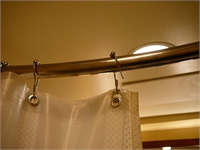
How to Install a Shower Rod
Important Notice: Our web hosting provider recently started charging us for additional visits, which was unexpected. In response, we're seeking donations. Depending on the situation, we may explore different monetization options for our Community and Expert Contributors. It's crucial to provide more returns for their expertise and offer more Expert Validated Answers or AI Validated Answers. Learn more about our hosting issue here.

How to Install a Shower Rod
You must be logged in to post a comment.
Shower rods come in two basic variations: adjustable rods and fixed rods. Adjustable rods are most often the standard straight rod that reaches from one side of an enclosed bathtub to the other. They operate using either an internal spring that provides tension against both walls or by an adjustable knob that, when twisted, lengthens or shortens the rod. Fixed rods are often used for more complex shapes and room designs that wouldn’t necessarily accommodate an adjustable rod. Fixed rods can be attached to the wall, the ceiling or to the framework of the shower or bathtub. The more elaborate fixed rods are often best left to professionals for proper installation, but the more basic fixed and adjustable rods can be installed by you without the need for any special tools.
Things you’ll need
Tape measure
Level
Curtain rings
(For Fixed Rods)
Painter’s tape
Hacksaw with metal cutting blade
Pencil
Mounting brackets with screws
Screwdriver
Adjustable Rods
Step 1
Measure the distance between the walls of the enclosed shower or tub. Use these measurements when choosing an adjustable rod. Adjustable shower rods have a minimum and maximum functional range, so make sure to choose one that fits the measurements of your shower. Measurement ranges are listed on the shower rod packaging.
Step 2
Place the shower curtain rings on the rod and hold it up to the location where you want to mount the rod.
Step 3
Extend the rod until it places enough pressure against each wall to hold the rod in place. Spring loaded rods can be extended by rotating one end in a counter-clockwise direction. Extend spring loaded rods approximately 1/8th to 1/4 of an inch beyond the measurements of your shower or tub area.
Step 4
Hang the curtain on the rings and adjust the height of the rod until the bottom of the curtain is at the desired distance from the floor.
Step 5
Place the level on top of the shower rod and make any necessary adjustments.
Fixed Rods
Step 1
Measure the length of your fixed shower rod and wrap tape around the end that needs to be cut to fit it to your shower walls.
Step 2
Mark the tape at the length where the rod needs to be cut and carefully cut off the excess with the hacksaw.
Step 3
Measure out the height from the floor to where you want the shower rod to be mounted and place a small mark on the wall with the pencil.
Step 4
Place one of the mounting brackets against the wall, positioned over the mark. Use the pencil to mark the locations of the screw holes in the bracket.
Step 5
Remove the bracket and place the tip of the screwdriver over each of the screw hole marks. Press firmly against the screwdriver to make small indentations in the wall in the center of each screw hole mark. This will make it a little easier to keep the screws centered when securing the mounting bracket to the wall.
Step 6
Place the mounting bracket against the wall and secure it using the included screws.
Step 7
Insert one end of the shower rod into the mounting bracket on the wall and place the remaining mounting bracket on the other end of the rod. Lift the free end of the rod up to the other wall and adjust the height until the rod is level. Once the rod is level, mark the screw holes for the unsecured wall mounting bracket.
Step 8
Remove the rod and use the screwdriver to make small indentations at the center of the pencil marks on the wall.
Step 9
Insert the rod back into the mounted bracket and place the shower curtain rings on the rod. Position the other end of the rod, along with the unsecured bracket, at the position you just marked with the pencil.
Step 10
Secure the second bracket to the wall with the included screws.
NOTE: Shower rods are not designed to bear any significant weight and should never be used to steady yourself when getting in and out of the shower. Doing so can result in potential injury and damage to your walls and shower rod.